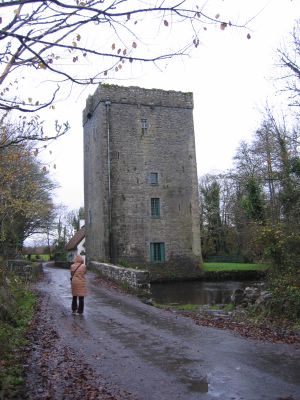A walk through Yeats' woods

Thoor Ballylee, WB Yeats' home in County Galway
My first visit to Ireland 12 years ago, 3 luxurious weeks wandering cow-paths in a tiny plastic car, left me addicted to Irish writers: Joyce, Synge, Yeats, Wilde... The one who most became part of me is Yeats. I remember seeing his grave on my first visit, and asking myself "Now, who is that? And who is this 'George my wife' with him?" Years later, the first English book I felt compelled to buy in Spain was a small Yeats collection. You never know when you might suddenly need a good dose of musical Irish poetry.
So last Tuesday, when Conor, our host at the bed and breakfast in Ballyvaughan, told me I was painfully close to Coole Park, Yeats' stomping grounds, I was tempted to try to sell my two Spanish companions on a rainy drive to the woods of an old manor house, to live poems they'd never read by a man they'd never heard of. If you want to understand Yeats, Conor told me over pudding and rashers of bacon, walk Coole Park in fall. I told him I love to travel alone as well, and I'd be back.
I had also asked him about Thoor Ballylee, the Norman castle Yeats restored when he felt, already over 50, a call to settle down in known country - in Galway, a walk away from Coole Park and his lifelong friend Lady Gregory. When the Salmantinas demanded a translation of Conor's passionate, speed-of-light English discourse over they-couldn't-tell-what, I did my best to tell the story of Yeats' unrequited loved for Maud Gonne and his endless proposals of marriage, the last as he was restoring Thoor Ballylee, after buying the long-abandoned tower for 35 pounds. When she turned him down, he proposed to her daughter, who holding tight to family tradition, also rejected him. Tower under construction, Yeats went to England, where he met and married the George I saw with him in the graveyard in Sligo. They raised a family in the Norman tower, and lived there during the Irish civil war, when Yeats wrote some of my favorite poems, contrasting the calm continuity of nature - bees moving into an abandoned starling nest in a hole in the tower, for example - with the bloodshed and destruction he saw around him.
Well, as Irish luck would have it, I was happily careening along a 2 lane cowpath outside of Gort in County Galway last Tuesday when a faded metal sign broke through the mist: Thoor Ballylee - 3 km.
I said something in Spanish, and was immediately reminded of how well I choose friends and travelling companions. An enthusiastic shout from the back seat
"¡¡A la torre del poeta!!"
was followed by an echo from my right and then a unified chorus
"¡¡A la torre del poeta!!"
The road to Thoor Ballylee is narrow, curved and canopied by the twisted old trees that line either side. A few kilometers from the main road we found a small deserted carpark. The tower, a short walk away, hosts a Yeats museum in the summer. I was ecstatic to arrive on a wet, dark day in fall. My companions quickly decided no one could live in this spot and NOT be a poet, a lovely Spanish thought that I am not sure I disagree with. Birds, moss, brush, and crumbling stones are everywhere, and the water gurgles and sings as it passes under the bridge.
The tower fell back into disuse after Yeats' death, until it was restored as a museum in the 60s.
The poem Conor felt this season would best "give" me at Coole Park is called The Wild Swans at Coole, and describes 59 swans that Yeats saw year after year in the woods at Coole. He wrote it while still living his solitary poet's life, and, so they say, saw himself as the 59th swan - the single solitary figure in a community that pairs for life. 29 pairs, and Yeats. I know the feeling, some dark days. Somehow, I almost preferred seeing not Coole Park, but the family home he willed himself to create when he decided it was time. Plus I always prefer to see things I serendipitiously stumble upon.
The picture above shows an intrepid Salmantina marching on to explore la torre del poeta, and below, you see the path that leads along the river bank, toward Coole Park. I like to think these are Yeats' own walking woods.
Visit the west of Ireland, wandering doesn't get any better than this.

Yeats' woods
Labels: wanders and travels







5 Comments:
WW, this is a truly wonderful walk! I have placed a link in my Cyber Walk post! Enjoy!
By Cream, at 1:45 PM
Cream, at 1:45 PM
Lovely.
By Anonymous, at 4:14 PM
Anonymous, at 4:14 PM
Thanks for the rich thoughts about all this and for sharing some of your passion.
I'll put Yeats on my reading list, now. :)
By Kate Winner, at 6:11 PM
Kate Winner, at 6:11 PM
This is a stunning piece of writing ... thanks for the tour. i studied him in uni back in early 2000. There's a wonderful pub over in Istanbul, it's called The James Joyce and its walls are adorned with the Irish writers.
By Di Mackey, at 9:51 AM
Di Mackey, at 9:51 AM
Türk porno
By ebru, at 3:57 AM
ebru, at 3:57 AM
Post a Comment
<< Home